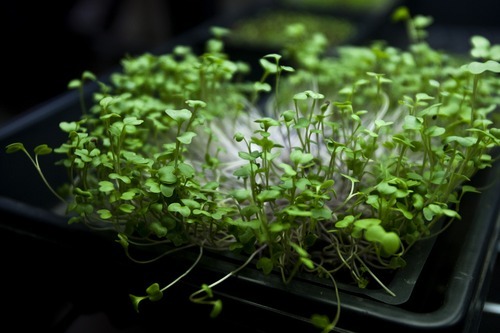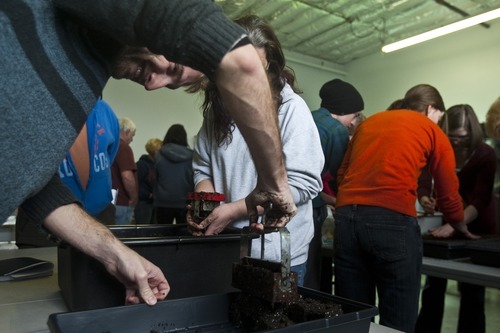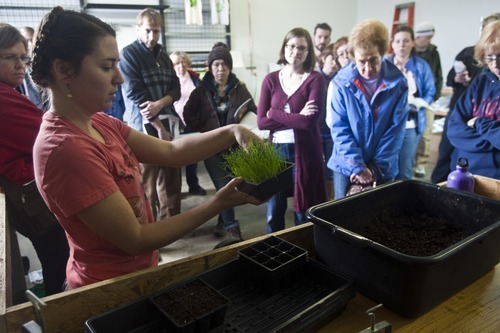This is an archived article that was published on sltrib.com in 2011, and information in the article may be outdated. It is provided only for personal research purposes and may not be reprinted.
The poet T.S. Eliot once called April "the cruelest month." For gardeners, February is worse.
That's when most gardeners might think they have to content themselves with thumbing through seed catalogs while watching the snow fall outside.
But that's not the case with Sharon Leopardi, who spoke to more than two dozen gardening enthusiasts at Mountain Valley Seed in Salt Lake City on Saturday morning for a workshop about seed selection and starting.
"You can start seeds pretty much now," she told attendees who, not long afterward, had their hands in the dirt, pressing onion starts and spinach seeds into long grower's trays of damp soil.
Leopardi taught the first hands-on workshop of the gardening season for Wasatch Community Gardens, a community-based nonprofit that helps people grow food in urban gardens. She told the class members it's smart to start with a plan that simply accounts for how much space is available for the plants they want to grow.
A crucial decision is deciding what to plant and when, either indoors with the help of fluorescent lights or outdoors when the soil is warm enough. Leopardi said she typically considers May 15 to 24 as the official window to consider as the last days of frost and the first days when it's generally safe to set into the garden the plants that suffer because of too much cold.
Leopardi also talked about the value of using sterile seed-starting soil. Bagged potting soil can be unhealthy and even fatal to small plants if the soil has bacteria or other contaminants, she explained.
One attendee asked about the right type of fertilizer. Leopardi recommended one with equal measures of phosphorus, nitrogen and potassium. She noted that seedlings will need a weekly feeding once they are transplanted.
"The more you harden them off in very gradual steps, the better," she said, saying that several rounds of 2-, 4- and eight-hour periods outdoors helps prepare the young plants for the garden bed.
How long should grow lights be used each day? Leopardi, who runs a network of urban gardens and starts the plants for them, said she turns them on when she rises and off when she goes to bed, since there's no evidence that using them all day and night helps plants grow any better.
For Donald Byrd, Saturday's workshop will be a big help as he prepares to grow a backyard garden at his West Jordan home. "I'm a novice," he said. "Houseplants is as far as I've gotten."
He's particularly excited about growing lemon cucumbers this year: "You can eat them like apples."
Carly Gillespie, community education coordinator for Wasatch Community Gardens, noted that her group offers more than 30 classes a year, all with modest tuition and liberal tuition-waiver policies. Their purpose is to help people grow their own food — a goal that has grabbed the interest of many more Utahns, partially because of the sluggish economy.
She noted that the waiting list for Saturday's class was bigger than the attendee list. Part of the reason was the recent spell of warm, sunny weather.
"People just get this feeling as the sun comes out," she said. "They're excited to do anything [that has to do with] gardening this year."
Salt Lake City residents Melissa Davis and Chad Swan said they started this year's garden last fall, with garlic and shallots that they learned how to grow at another Wasatch Community Gardens workshop. Davis is looking forward to trying new things, like chard.
"The possibilities," she said, smiling and eyes widening, "are endless." —
Wasatch Community Gardens workshops
The seed-starting guide is online at http://bit.ly/gkZprq. Guides on local farmers markets, how-to handouts and other useful tips for urban gardeners are available on the group's website. Seeds and supplies for starting them are available at the Mountain Valley Seed store, 455 W. 1700 South, mvseeds.com.









